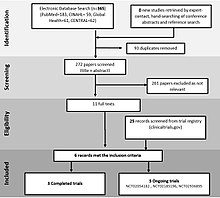Preferred Reporting Items for Systematic Reviews and Meta-Analyses

PRISMA (Preferred Reporting Items for Systematic Reviews and Meta-Analyses) is an evidence-based minimum set of items aimed at helping scientific authors to report a wide array of
The PRISMA statement
The aim of the PRISMA statement is to help authors improve the reporting of
History
In 1987, Cynthia Mulrow examined for the first time the methodological quality of a sample of 50 review articles published in four leading medical journals between 1985 and 1986. She found that none met a set of eight explicit scientific criteria, and that the lack of quality assessment of primary studies was a major pitfall in these reviews.[4] In 1987, Sacks and colleagues[5] evaluated the quality of 83 meta-analyses, using a scoring method that considered 23 items in six major areas: study design, combinability, control of bias, statistical analysis, sensitivity analysis, and application of results. Results of this research showed that reporting was generally poor; and pointed out an urgent need for improved methods in literature searching, quality evaluation of trials, and synthesizing of the results.[citation needed]

In 1996, an international group of 30 clinical epidemiologists, clinicians, statisticians, editors, and researchers convened The Quality of Reporting of Meta-analyses (QUOROM) conference to address standards for improving the quality of reporting of meta-analyses of clinical randomized controlled trials (RCTs).
In 2009, the QUOROM was updated to address several conceptual and practical advances in the science of
In 2021, a 'PRISMA for Searching' (PRISMA-S) guidance was added[9] and published,[10] to improve the literature searches of systematic reviews, which are accentuated to "underlie the foundations of systematic review".
Components
Checklist
The checklist includes 27 items pertaining to the content of a systematic review and meta-analysis, which include the title, abstract, methods, results, discussion and funding.
Flow diagram
The following is an example of a PRISMA flow diagram:

Impact
The use of checklists like PRISMA is likely to improve the reporting quality of a systematic review and provides substantial transparency in the selection process of papers in a systematic review. The PRISMA Statement has been published in several journals.[12][13][14][15][16]
Many journals publishing health research refer to PRISMA in their Instructions to Authors and some require authors to adhere to them. The PRISMA Group advised that PRISMA should replace QUOROM for those journals that endorsed QUOROM in the past.[citation needed]
Recent surveys of leading medical journals evaluated the extent to which the PRISMA Statement has been incorporated into their Instructions to Authors. In a sample of 146 journals publishing systematic reviews, the PRISMA Statement was referred to in the instructions to authors for 27% of journals; more often in general and internal medicine journals (50%) than in specialty medicine journals (25%).[17] These results showed that the uptake of PRISMA guidelines by journals is still inadequate although there has been some improvement over time.[citation needed]
Approximately 174 journals in the health sciences endorse the PRISMA Statement for the reporting of systematic reviews and meta-analysis published in their collections.[18] PRISMA has been also included as one of the tools for assessing the reporting of research within the EQUATOR Network (Enhancing the Quality and Transparency of Health Care Research), an international initiative that seeks to enhance reliability and value of medical research literature by promoting transparent and accurate reporting of research studies.[citation needed]
See also
References
- ^ "PRISMA". www.prisma-statement.org.
- ^ Regona, M.et al Opportunities and Adoption Challenges of AI in the Construction Industry: A PRISMA Review. J. Open Innov. Technol. Mark. Complex. 2022, 8, 45. https://doi.org/10.3390/joitmc8010045
- ^ PMID 19621070.
- PMID 3813259.
- PMID 3807986.
- ^ S2CID 21826935.
- PMID 33782057.
- PMID 33781993.
- ^ "PRISMA for Searching". Retrieved 20 August 2022.
- PMID 33499930.
- .
- PMID 19621072.
- PMID 21603045.
- PMID 19622551.
- S2CID 22128517.
- PMID 20171303.
- PMID 22110690.
- ^ PRISMA Endorsers. http://www.prisma-statement.org/Endorsement/PRISMAEndorsers
External links
- PRISMA Statement
- EQUATOR Network (Enhancing the Quality and Transparency of Health Care Research
